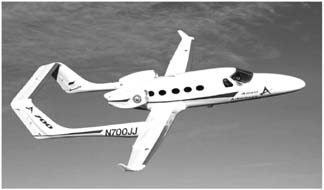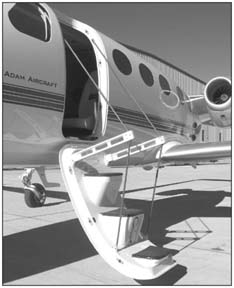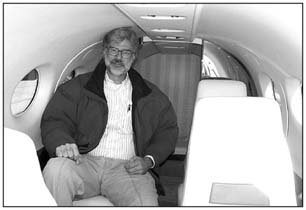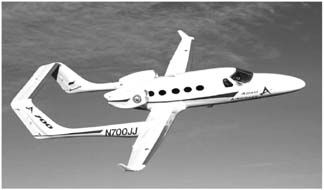
by Rick Durden
The very light jet market is so new that even the right name for this category of airplanes is up in the air. A reader of our online publication, www.avweb.com, wrote to propose that mini-jets be called QFVs, for quick flight vehicle.
Whatever theyre called, theyre coming but were less worried about what to call them than whether the Type A personalities who will buy the new jets will actually be able to fly them. Or will the countryside again be littered with airplanes as when lawyers and doctors with more money than good sense bought Bonanzas and Aerostars, only to make expensive smoking holes?
Jets are different. Theyre easier to fly than pistons, but there are distinct differences that need to be integrated into a pilots psyche. For example, because theyre quiet, jets offer few aural cues as to what the airplane is doing. No rising prop noise, no changing vibes. Things can happen slowly in a jet, then spin wildly out of control as the pilot gets behind the jet engines characteristic power lag. In cruise or transition to the terminal, a piston driver used to 180 knots may be stressed when flying 350 knots in a jet.
So, does an average piston driver have any hope of mastering a mini-jet?To find out, we recently flew the prototype Adam A700 and we approached the evaluation from two perspectives: Whats the status of the airplane and what has Adam done to make sure owner-pilots-amateur jet jockeys-can fly it safely?
In context, the accident record of owner-flown, single-pilot Cessna Citations and CitationJets has been good, but the numbers are small and training is legislated by insurors.When 5000 of these jets are flying, things may be different.
The Numbers
As we reported in the August 2004 issue, the A700 is an all-composite aircraft with gross weight expected to be about 7000 pounds against an empty weight targeted at 3700 pounds. Claimed NBAA range with reserves is 1100 miles with three aboard.
Power comes from the recently certified Williams FJ33 engines, which can develop as much as 1536 pounds of thrust. On the A700, theyre de-rated to 1200 pounds, which will initially give some thermodynamic breathing room and potentially extend engine life, but will also allow space for Adam engineers as they fight the inevitable weight creep in the design, something that appears to have forced Eclipse to move to a larger engine on its jet, delaying development.
The A700 has roughly two-thirds of its parts in common with its sibling, the A500 piston twin. This should allow Adam to develop its jet for less of the long green than had it simply started with a jet. The A500 is encountering some certification delays but Adam expects approval by the end of the first quarter of 2005, with deliveries later in the year. The jet prototype has been flying since the summer of 2003, when it surprised everyone at Oshkosh by arriving under its own power while other companies were showing mock-ups.
We were briefed on the current status of the prototype and learned that the Williams engines don’t yet have the full authority digital engine control (FADEC) that will be on production engines because Adam got the engines a year before the FJ33 had finished certification.
While the engines conform to the certified version of the FJ33, we flew the airplane with conventional power levers. Its anticipated that the production airplane with FADEC would have power set by moving the levers to detents appropriate for the portion of flight involved; computers take care of the rest. This is done in more sophisticated bizjets such as the Cessna Citation X. FADEC will also mean that residual idle thrust will be lower, perhaps eliminating the need for complex thrust reversers, as Cessna discovered when it certified the CJ3.
The prototype doesnt have the belly fuel tank installed, which will boost available fuel from its current 230 gallons to about 360 gallons, or just over 2400 pounds. The fuel system is simple; wing fuel drains into the belly tank from which the engines draw. Fuel selection is off or on for each engine.
We were told that the belly fuel tank will be protected from impact by integral skids and that it wont extend as far below the fuselage as do the twin tail booms.
The weight of the increased fuel quantity is largely offset by the reduction in weight from replacing the A500s piston engines with the lighter turbine powerplants on the A700. Fuel burn is expected to be 400 pounds per hour at 38,000 feet while generating 340 knots true airspeed.
Its interesting to observe the progression of fuel efficiency in fanjets: The original Cessna Fanjet 500-which became the Citation I-cruised at 340 knots and burned 1000 pounds per hour. The CJ1 cruised at the same speed but its Williams engines reduced the fuel burn to 600 pounds per hour, a 40 percent improvement. The next generation Williams engines on the A700 are predicted to provide yet another 40 percent reduction in fuel burn at the same cruise speed.
The electrical system has two batteries located in the tailcone, keeping cable runs short. The 200-amp starter generators are the same as those used on other jets, however, Adam reports that its soft start system, which launches the start sequence with one battery and then brings in the other, draws so little power that the batteries are capable of 22 starts without recharging. There’s a third battery, isolated other than for charging, that functions as a reserve, primarily for the FADEC, should everything else go dark.
Fix it Fast
During our briefing, much was made of Adams desire to insure dispatch reliability. Roughly 90 percent of the systems that are likely to experience failure or require routine maintenance are located in the tail of the airplane, where they can be reached easily. The hydraulic system (flaps and gear are electro-hydraulic) and the blow-down emergency gear extension system have all primary components mounted on a skid in the left boom just aft of the wheel well, so it can be removed and replaced quickly.
The engines are uni-handed, meaning they have mounts on both sides as we’ll as dual oil fillers and dipsticks, so that an operator doesnt have to keep right- and left-handed engines in stock. We were told that to remove and replace an engine will take four hours. The philosophy is to keep the airplane in the air and if something goes wrong with an engine that cant be immediately diagnosed and fixed, it comes off for bench work while the airplane flies on with a replacement engine.

Flight controls are a combination of push-pull rods and cables. Brakes are standard Clevelands, not carbon brakes, to save maintenance cost and weight. Avionics will be the Avidyne Entegra system, with two PFDs-one for each side of the cockpit-and an MFD in the center. Avidyne was chosen because there are some 1000 units currently in the field and Adam wanted an integrated unit, rather than one which has remotely mounted boxes, as Garmins G1000 does. Adam felt that an integrated unit has shorter wiring runs and is easier to replace when dispatch reliability is an issue.
The A700 prototype is not small, although it appears nicely compact. While its longer than the A500, it somehow doesnt feel as large, perhaps because the length makes it appear sleeker. The interior is roughly the size of a King Air 90 or CJ1. When we flew the prototype, a sample passenger interior was installed, although passengers could not legally be carried.
We did try the seats, including the aft potty chair, and we found that our 6-foot-4-inch frame was a tight fit, with no headroom to speak of. However, the pilots seat had adequate leg, elbow, head and knee room, although with the seat set full aft, it impinged on the airstair door, making it difficult to close. Thats one of the myriad headaches the engineers get to solve during any aircraft certification project.
Cockpit layout is efficient, with avionics and switches within easy reach. We liked the side stick control for two reasons: it opens up a clear view of the panel and its out of the way in the event of a crash.Thankfully, there are no switches or gauges on the cabin ceiling.
Low-Altitude Trial
For our flight, the pressurization system wasnt installed and without oxygen, we were limited to 12,500 feet. We were told that the performance envelope is being expanded progressively, so for our operation, top speed was 160 knots, with 100 knots as the minimum speed for single- and multi-engine operation.
Start-up, as with any jet, is wondrously simple. Hold the start lever down and when N1 RPM reaches 8 percent, move the power lever out of the cut-off detent to idle to introduce fuel. Monitor the temps to see that they stay within limits and at 45 percent N1, let go of the start lever.
Taxiing is via differential braking and proved easy with the wide landing gear. We noted that the airplane would slow down and eventually stop at idle thrust when taxiing, giving us a hint that attenuators will not be needed on the production airplanes. Most jets keep accelerating slightly when taxiing at idle thrust.
The pre-takeoff checklist is short, allowing it to be completed we’ll before getting to the runway. We ask test pilot Tom Wiesner to show us the ailerons-neutral position of the side stick, as its canted inboard slightly. Once learned, it fell easily to hand subsequently.
With just two aboard and no belly tank, we were light, at the Englewood, Colorado runway elevation of over 5000 feet. Density altitude was more than 6000 feet. Rotation speed was set at 80 knots with approach flaps selected and we were advised to climb at 120 knots after retraction of gear and flaps.
Acceleration was what one expects in a small jet, which is to say it shoves you back in the seat and the first time you experience it, you get the adrenalin rush of being fired from a slingshot.
Eighty knots came in a matter of seconds, so fast that we immediately understood why this airplane is expected to have a balanced field length of less than 3000 feet. With trim neutral, an estimated 25-pound pull was needed to rotate and after the gear and flap retraction, the aircraft was pitched up to 22 degrees to hold 120 knots. The VSI was pegged at 4000 FPM.
Easy Handling
At 12,500 feet, 65 percent N1 generated 160 knots, although without gear doors or the belly pod, any attempt to suggest performance numbers is premature. Control harmony was excellent with handling being noticeably firm. The closest comparison we can offer is to the pleasant handling of a 400-series Cessna. Rudder was needed to coordinate turns, an unusual trait in jets, but it seemed to add to the overall enjoyable handling.
We found no hint of dead areas or slop in the controls; response was immediate and crisp in all axes. Pitch trim speed seemed appropriate, especially for speed and configuration changes. We noted that the airplane was one of the easiest to trim in pitch that weve flown and it would stay within 2 knots of a desired speed with minimal effort.
Gear extension/retraction had no effect on pitch but flap extension resulted in a pitch-up moment. The side stick made maneuvering flight enjoyable; steep turns trimmed easily and even going twice around in each direction didnt scrub much airspeed.
Steep turns revealed a shortcoming in the aircraft: poor upward visibility. While it may be difficult to extend the windshield upward, with a composite structure, adding eyebrow windows is feasible and would substantially improve visibility, particularly in maneuvering flight or in the traffic pattern. That should be of value in a single-pilot jet.
With gear and flaps extended, the slowest speed we flew during our trials was 100 knots, where we found the airpplane has conventional handling traits.We werent flying slowly enough to require significant application of power, leading us to believe that even as weight increases, reference speeds on landing will probably be in the 95-knot range.
Fast Spool
The FJ-33s accepted rapid power changes without hesitation and spooled from idle to roughly full power in about 5 seconds, with most of the thrust increase occurring after about one second and then tapering off as it neared 100 percent. Such a demo will sell airplanes to pilots whove flown only pistons.

At 100 KIAS with both power levers at idle, we firewalled one engine. Acceleration was steady, on the order of a knot every two seconds. With feet on the floor, the ball deflected less than a full diameter. We wonder if this positive trait would prompt Adam to seek centerline thrust certification. No, says Adam, it wont. Rudder force required to maintain directional control was minimal; we would estimate less than 40 pounds. The prototype doesnt have speed brakes, although we were told production aircraft will, something we think the airplane will need. In our descent, we werent able to come down at 2000 FPM and stay under 160 knots. In the traffic pattern, 140 knots was recommended on downwind, with approach flaps and the gear extended.
Base is flown at 120 knots and final at 100 knots with full flaps. These are basically piston twin-type speeds. The airplane is easy to fly at slow speeds and control response doesnt get sloppy or require large inputs, as is the case with some bizjets. Power is reduced to idle at about 35 to 50 feet and the airplane is flared for landing, as with a piston.
If the air is smooth, one can feel the airplane enter ground effect. For our weight, 100 knots proved fast; the combination of residual thrust and ground effect caused the airplane to float quite a distance before it settled onto the trailing beam main gear at 80 knots. Thanks to impressive elevator authority, the nose can be held off the pavment for aerodynamic braking.
What about short or slick runway ops? Our opinion is that because of the wide gear stance, assuming good anti-skid and that FADEC will reduce residual thrust at idle, the potentially slow touchdown speed should obviate the need for reversers. Only operational experience will bear that out, however.
Conclusion
Clearly, Adam has produced an airplane whose handling hits or is close to the mark for the step-up piston driver. Because the prototype was altitude and speed limited, we cant verify Adams claims concerning critical items such as speed, payload and range. we’ll have to tend to that when the project is further along.
For now, all we can say is so far, so good. None of the other jet projects seem quite as developed as Adam is. Although Eclipse is close, they havent given us a shot a flight trials just yet. Stay tuned.
Also With This Article
“Checklist”
“Jet Revolution or Lawn Darts?”
“Light Jet Scorecard”
-Rick Durden is an Aviation Consumer contributing editor.





